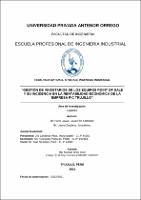| dc.contributor.advisor | Urcia Cruz, Manuel | |
| dc.contributor.author | Farro Layza, Laura Flor Katherine | |
| dc.contributor.author | Lizana Zavaleta, Josealonso | |
| dc.creator | Farro Layza, Laura Flor Katherine | |
| dc.date.accessioned | 2022-01-22T11:32:23Z | |
| dc.date.available | 2022-01-22T11:32:23Z | |
| dc.date.issued | 2022 | |
| dc.identifier.uri | https://hdl.handle.net/20.500.12759/8593 | |
| dc.description.abstract | La empresa PIC Trujillo se dedica al rubro de la compra/venta de equipos “Point
of Sale” para su comercialización, los cuales se dividen en Full, Pro y Junior. En
la presente tesis, se tratará de calcular la cantidad de pedido a solicitar a inicio
de mes, a fin de evitar el desabastecimiento de productos e inconformidad con
el cliente, problemática que origina que la organización no cumpla con las
demandas solicitadas ni el tiempo de entrega predeterminado con el cliente.
Según los datos históricos de la demanda aportados por el gerente, Agosto 2020
a Julio 2021, la tendencia registrada entre dichos meses nos han ayudado a
identificar que el método a utilizar sería el de promedio móvil ponderando (n=3),
realizando así el pronóstico de la demanda desde Agosto 2021 a Marzo 2022.
Se propuso a la empresa trabajar con el modelo de cantidad de periodo fijo (P),
con el fin de calcular la cantidad de pedido adecuada de los equipos POS y así,
aumentar la rentabilidad económica. Este modelo nos ayudará a optimizar los
costos de pedido, los costos de envío y los costos de déficit y sobre stock. Para
su cálculo fue necesario recopilar la información de la demanda mensual
promedio, la desviación estándar de la demanda, el nivel de confianza (z = 2.05),
el inventario actual, el tiempo de entrega del proveedor y el tiempo de revisión
de inventario.
Finalmente, se concluye que al aplicar este modelo P en los meses de Agosto
2021 a Marzo 2022, la rentabilidad económica mejoró a un 82%, esta mejora se
debe a la correcta administración del sistema de gestión de inventarios para la
empresa. | es_PE |
| dc.description.abstract | The company PIC Trujillo is dedicated to the business of buying / selling “Point
of Sale” equipment for its commercialization, which are divided into Full, Pro and
Junior. In this thesis, we will try to calculate the order quantity to be requested at
the beginning of the month, in order to avoid the shortage of products and
disagreement with the client, a problem that causes the organization not to
comply with the requested demands or the time of default delivery with customer.
According to the historical demand data provided by the manager, August 2020
to July 2021, the trend registered between those months has helped us to identify
that the method to use would be the moving average weighting (n = 3), thus
making the forecast of demand from August 2021 to March 2022.
The company was proposed to work with the fixed-period quantity model (P), in
order to calculate the appropriate order quantity for the POS equipment and thus
increase economic profitability. This model will help us optimize order costs,
shipping costs, and shortfall and overstock costs. For its calculation, it was
necessary to collect the information of the average monthly demand, the standard
deviation of the demand, the confidence level (z = 2.05), the current inventory,
the supplier delivery time and the inventory review time.
Finally, it is concluded that when applying this P model in the months of August
2021 to March 2022, the economic profitability improved to 82%, this
improvement is due to the correct administration of the inventory management
system for the company | en_US |
| dc.description.uri | Tesis | es_PE |
| dc.format | application/pdf | es_PE |
| dc.language.iso | spa | es_PE |
| dc.publisher | Universidad Privada Antenor Orrego | es_PE |
| dc.relation.ispartofseries | T_IND_170 | |
| dc.rights | info:eu-repo/semantics/openAccess | es_PE |
| dc.rights.uri | https://creativecommons.org/licenses/by/4.0/ | es_PE |
| dc.source | Universidad Privada Antenor Orrego | es_PE |
| dc.source | Repositorio Institucional - UPAO | es_PE |
| dc.subject | Equipos | es_PE |
| dc.subject | Rentabilidad | es_PE |
| dc.title | Gestión de inventarios de los equipos POINT OF SALE y su incidencia en la rentabilidad económica de la empresa PIC Trujillo | es_PE |
| dc.type | info:eu-repo/semantics/bachelorThesis | es_PE |
| thesis.degree.level | Título Profesional | es_PE |
| thesis.degree.grantor | Universidad Privada Antenor Orrego. Facultad de Ingeniería | es_PE |
| thesis.degree.name | Ingeniero Industrial | es_PE |
| thesis.degree.discipline | Ingeniería Industrial | es_PE |
| dc.subject.ocde | https://purl.org/pe-repo/ocde/ford#2.11.04 | es_PE |
| renati.advisor.orcid | https://orcid.org/0000-0001-8286-0597 | es_PE |
| renati.author.dni | 72907403 | |
| renati.author.dni | 70672817 | |
| renati.advisor.dni | 18208167 | |
| renati.type | https://purl.org/pe-repo/renati/type#tesis | es_PE |
| renati.level | https://purl.org/pe-repo/renati/level#tituloProfesional | es_PE |
| renati.discipline | 722026 | es_PE |
| renati.juror | Landeras Pilco, María Isabel | |
| renati.juror | Granados Porturas, Pablo | |
| renati.juror | Sato Nestares, Paul | |
| dc.publisher.country | PE | es_PE |


